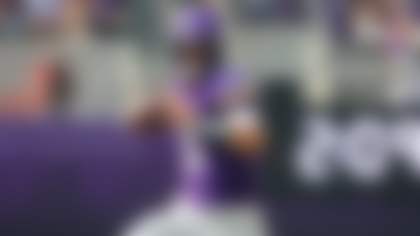In his robust Inside The NFL Notebook below, NFL Network's Albert Breer touches on multiple topics, including (click on each link to take you directly to the topic):
» Four things he's looking forward to in Week 16.
» One highly dangerous team as the playoffs approach.
» A prediction on Jon Gruden's future.
» And much more, beginning with a look at why Kyle Shanahan is on the head-coaching fast track ...
Chris Cooley was cut by the Washington Redskins on Aug. 28. The veteran tight end then returned to the team on Oct. 22.
It's pretty tough for him to comprehend what transpired in the eight weeks in between.
"When I got back, it was a new offense," Cooley recounted recently. "The learning curve for me was drastic. I missed seven games. The last game I didn't play was against the Giants. I watch all the games and I'm in tune to what we're doing, [but] I couldn't have called a third of the plays in that game. I couldn't have told you what they were, what the responsibilities were. The way they'd grown from Week 1 to Week 7 was unreal."
So is the ascension of Redskins offensive coordinator Kyle Shanahan on lists of potential head-coaching candidates. And Cooley's explanation hints at the primary reason why.
After leading a middling offense his first two years in Washington (ranked 18th and 16th in the league) under his father, the younger Shanahan retrofitted the traditional scheme Mike Shanahan has run around the talents of Robert Griffin III, for whom the 'Skins yielded a ransom to draft. Kyle installed concepts that Griffin ran at Baylor, mixed them with the old stuff, and created a unique attack designed to put his rookie quarterback in the best spot to prosper quickly. It worked. To wit:
Exihibit A: Griffin's 104.2 rating, 66.4 completion percentage and 18-to-4 TD-INT ratio.
Exhibit B: Washington now ranks fourth in total offense.
Exhibit C: With Griffin out in Week 15, it was easily adjustable to fit Washington's other rookie quarterback, Kirk Cousins.
"He's definitely exaggerating a little bit, just talking like Cooley does," Kyle Shanahan said over the phone, when apprised of his tight end's comments. "The whole basics of the zone read, we'd worked on that, did it really hard, put time into it from a Football 101 standpoint starting in OTAs, going from normal formations, getting the O-line right, getting the quarterback and running backs on the same page with the ballhandling. What Cooley saw was the simple ways to do it. That was the first couple games."
From there, the Redskins have kept defenses on their toes not by changing the concepts, but expanding the looks.
It's working. Washington topped the league in rushing at the quarter pole, stood second both at the midway point and after Week 12, and has risen back up to first since. So at this point, the idea that other teams would simply "catch up" to the problems the Redskins have created with their unique attack looks shaky.
"We've added moving parts -- out of crazy formations, running guys across the formation, bringing receivers in the backfield," Kyle continued. "Each week, we add to it. We got most wild with it the first time we played the Giants. To me, a lot of it is illusion. And it all goes back to what we've already done. The teaching has never really changed. The window dressing has. We can make it look like a lot of different stuff."
Kyle Shanahan's motivation to innovate here, more so than within the actual schematics, helps explain why he will draw interest from other clubs in need of a head coach this offseason. The 33-year-old chose to base his offense around the talent on hand, rather than forcing the talent to adapt to his ways. Which is to say he's inventive enough to be adapatable, something that would help any coach get the most out of his players.
In Griffin's case, Kyle said, "When we studied him, we saw a lot of things he did well, but (the zone-read) is what he did best, and we weren't going to take that away from him." So the Redskins went about trying to take what Griffin did best and make it something the offense could do well.
The interesting thing is that as Kyle Shanahan compiled tape of Baylor -- as well as the Tim Tebow-quarterbacked Denver Broncos, the Cam NewtonCarolina Panthers and the Vince Young Tennessee Titans, to see how NFL defenses were combatting the option -- neither he nor any other Redskins coach consulted with any outside coach or option guru.
"I'm kinda glad we didn't," Kyle said. "Because of that, we had to look at it hard, study more tape, and we wound learning it better and coming up with our own impressions."
Daniel Jeremiah says Kirk Cousins is just one of the men who kept the Redskins on track without RG3. **More ...**
As you might expect, he scoffs at the notion that it's any kind of gimmick.
Kyle explains that the offense forces defenses to account for 11 players rather than 10, since the quarterback is part of the play. This opens up things everywhere else on the field. Washington runs, by Kyle's count, about nine plays per game off the read-option and the threat it creates. And when the Redskins are running it -- not playing off it -- an extra gap is created. It plays the angles and is built to put defensive guys in bad spots, which, he reminds, is offensive football.
Kyle concedes it can't be all you do in the NFL. But it can be an important element, so long as you can keep your quarterback upright.
"We don't want Robert to get hit, but the thing I've noticed is that people notice when he gets hit running the ball," Kyle Shanahan said. "But they don't realize how violent it is in the pocket. ... He doesn't get hit like (Matt) Schaub did or Rex (Grossman) did. Robert will do that (dropback) stuff, but with the threat of the zone-read, and the fact that he's not sitting there, defensive linemen aren't teeing off on him. It's not the same."
Still, to make it work, the Redskins have built in rules for Griffin. In scramble situations, he's only to run when he's not accounted for by the defense. And in most of those spots, he's told to use the angles and run to the sideline. They're coaching him to slide some, and get out of bounds more -- on option plays, too.
Kyle Shanahan also mentions that Griffin's two injuries this year came on scrambles, not designed runs.
Mike Shanahan told me earlier in the season that he expects the offense to be in a state of evolution for the first three years of Griffin's career, something evident in the way Kyle's running things. And maybe the best thing? In part because both the option looks and the old offense are rooted in zone-blocking concepts, it's easy to go back and forth in scheme, which allowed the Redskins to smoothly transition to Kirk Cousins last week. But again, the idea remains the same.
"You can't just turn it on and become a pocket passer. Most guys who are have been since they were born," Kyle Shanahan said. "They've been throwing from the pocket and reading coverages since Day 1. Robert's such a good athlete that he hasn't had to do that. He understands football, and he can do it. He works at it, and the way he thinks and works, he's gonna be good at everything. This is just what he does best now."
It doesn't take Amos Alonzo Stagg to recognize that. But it did take skill, and guts, to build it like this.
So far, it's paid off for the Redskins. Soon enough, it should pay off for Kyle Shanahan too.
Four things I'll be looking for on Sunday
1) Seeing which New York Giants team shows up. The easy comparison to draw for this year's Giants is last year's Giants, who needed to beat the Jets and Cowboys in the final two weeks of the regular season to make the playoffs -- just like the 2012 team has to beat the Ravens and Eagles over the next two weeks to get in. It's easy to forget that the high-wire act hasn't always worked to the favor of Tom Coughlin's team. In 2010, New York suffered an unsightly Week 15 loss (just like last year and this year), blowing a 31-10 fourth-quarter lead to Philly and turning the final two games of that season into must-wins. The next week, Eli Manning threw four picks in a blowout loss to Green Bay, which took the final playoff spot from the Giants on a tiebreaker and wound up winning the whole thing. And in 2009, the Giants lost their final two games to fall to 8-8 and out of the postseason. "I don't think we want it to happen. It's just something that happens," Hakeem Nicks told me, when asked about these spots the Giants put themselves in. "You don't like to dwell off last year. But at the end of the day, we know what we can do, we know what we're capable of doing." Capable? Yes. A sure thing? Not even close.
2) The New England Patriots' onslaught. The Pats go to Jacksonville frothing at the mouth after their first loss in two months, still clinging to hopes that Denver could trip up and they could grab one of the AFC's two byes. And as much as the loss to the San Francisco 49ers must sting, New England still reached the end zone on four straight possessions to surmount a 28-point deficit against the league's most feared defense. The reason? The standard, as Deion Branch explained to me, couldn't be higher: "There's no need to play this game if you don't strive for perfection. And we know there will be mistakes made. But we have to focus on being a little more consistent and controlling the things we can control. You can look at the film, and I'm pretty sure the guys would say, 'When we were stopped, it was us. It was nothing they were doing.' And that's the stuff that makes you mad." They'll be plenty mad, and chances are that anger will add up to a lot of points against the lowly Jags.
3) Russell Wilson vs. the San Francisco 49ers' defense. The Seattle Seahawks' electrifying rookie has really only had two face-in-the-pavement games as a pro: at St. Louis in September and at San Francisco in October. Since that bad night at Candlestick, Wilson hasn't had a game where he threw more picks than touchdown passes and the Seahawks are 5-2. And at home, he continues to be off-the-charts good, with a completion percentage of 61.3, a TD-INT ratio of 12-to-1 and a 118.4 passer rating. Sunday night, he gets the chance to atone against San Francisco, with the Niners visiting Seattle. And listening to Pete Carroll, it's clear so much more is expected now. "For a team, we were just trying to get the offense going and not screw it up and make sure he could keep growing," Carroll said after the 50-17 win over Buffalo in Toronto. "We're past that now." As is the case with Griffin in Washington, Seattle has fostered Wilson's development by incorporating option and moving-pocket elements that allow him to play more instinctively. San Francisco's defense, which wasn't happy with its second-half lull in New England and will look to reestablish its dominance, will provide a good gauge for how far Wilson has come.
4) Ben Roethlisberger's big day. So maybe it's one of those "How was play otherwise, Mrs. Lincoln?" things to say, but Roethlisberger was pretty solid in Dallas, outside of the disastrous interception to Brandon Carr. And there's reason to believe the Pittsburgh Steelers will be mighty dangerous as a No. 6 seed (remember 2005?) if they do get into the tournament. Amazingly enough, it's still all in their hands. The biggest hurdle in getting there comes this week, with the Cincinnati Bengals' rugged defense paying a visit to Pittsburgh. This is when Roethlisberger must show his growth within Todd Haley's offense. Put the overanalysis of Big Ben's postgame words aside. Everyone knew this wasn't always going to be the smoothest relationship-building effort, because Haley can get hot and Roethlisberger can be immature and headstrong. But for the most part, I'm told, the two guys have navigated it fine. Sunday's reaction from Roethlisberger was simply a matter of emotion. Both men know they'll be judged on what happens between the lines. And this Sunday will go a long way in deciding how the bottom line here is written.
Three conclusions
1) The Steelers -- and others -- can learn from Washington thriving behind Kirk Cousins. I'd expect that Cousins' name will be floated out there plenty this offseason as a potential answer for someone at quarterback. But to trade him would defeat Washington's purpose in drafting him, which was to add a valuable piece at a bargain-rate and backstop an athletic quarterback with a player who can win games as a pinch-hitter. Sunday's an example of why the Redskins would be more likely to hang on to Cousins for three years, maybe draft another quarterback in 2014, then deal him off for picks in 2015 (when he has one year left on his rookie deal). Imagine if the Steelers had such a player. Pittsburgh has done so much correct over the years, but one mistake has been its reluctance to develop a young player to back up Roethlisberger, whose playing style subjects him to a beating. The Steelers have drafted just two quarterbacks, Omar Jacobs and Dennis Dixon, since Roethlisberger got there, and it's cost them games the last two years. You have to wonder if the Colts, Niners and Seahawks will think about drafting a backup at the position next year, too, based on the ways they employ their young signal-callers.
2) It's time for a clean-break between the New York Jets and Mark Sanchez. One Tennessee Titans official watching Monday night's game referred to the quarterback as "awful" and asked, "How do they have six wins?" It's not hard to see: Sanchez looks like a defeated player. But some in the NFL don't see him as a totally lost cause. "He may benefit from a change of scenery," said one AFC executive. "I think what's done is done, and mentally, the program in New York may have taken its toll and killed his confidence, especially when you have the innuendo that the organization may not have had total faith in you. A fresh start and a team that wants you can invigorate some confidence. But now, you know what he is: a quarterback who will do far better when he has a run game and a defense that will just let him be the bus driver." And that's the problem in New York. When you've invested in a player like the Jets have in Sanchez, that's simply not enough.
3) The Green Bay Packers are dangerous as ever. And that's despite the bone-headed decision to run that throwback on the punt return, a debacle that added tense moments to what should've been a comfortable win. Jordy Nelson told me at the end of November that this season was unfolding in a fashion "very similar" to 2010. Nelson added that "you can't rely on it, but you know there's a chance." Same as then, the Packers are dealing with a ton of injuries now, and getting hot at the right time. They've won eight of nine, and done so despite injuries to Clay Matthews, Charles Woodson, Greg Jennings and Nelson, among others. They've shown depth, and a versatility to win games in different ways. And their presence, potentially, as the third seed in the NFC shows the strength of the conference, with that side of the bracket promising to be as competitive as we've seen it in years.
Two college players to watch this week
1) BYU pass rusher Ezekiel Ansah (vs. San Diego State, Poinsettia Bowl, Thursday, 8 p.m. ET, ESPN): This 6-foot-6, 270-pound specimen arrived at BYU as a track athlete from Ghana in 2008, and first went out for the football team in 2010. This fall, in his first season starting, he posted 57 tackles, 13 tackles for losses, 4.5 sacks and eight pass break-ups. "He's very intriguing," an AFC executive said. "Very high upside factor, but risk from his lack of a football background and pedigree. If you hit with him, I see a lot of potential." I asked an NFC exec if this is like Jason Pierre-Paul -- another ridiculously talented edge player who was very raw coming out of college -- and the answer was simply, "Yes." You'll be hearing plenty about this kid in the coming months.
2) Washington CB Desmond Trufant (vs. Boise State, MAACO Bowl Las Vegas, Saturday, 3:30 p.m. ET, ESPN): The younger brother of Seahawks CB Marcus Trufant and Jets CB Isaiah Trufant, Desmond Trufant is "probably a third- or fourth-round prospect and the best player in that (bowl) game," according to an NFC exec. The aforementioned AFC executive said Trufant has "cover skills, speed and quickness, average size and some limitations in strength, but can run and cover." Boise's passing game, though it might not be quite what it's been in the past, should provide Trufant with a good final shot to effect his stock positively going into the evaluation process.
One prediction
Jon Gruden will remain in the booth. The rumor mill has been spinning furiously, as it so often does, around the former Raiders and Buccaneers head coach. And there are plenty of whispers out there connecting him back to Philadelphia, which was his final stop as an assistant -- he was offensive coordinator there under Ray Rhodes -- before he got the Raiders job in 1998.
I personally think he stays out another year. At least.
Harrison: Week 16 Power Rankings
A new team at the top, a new team at the bottom and plenty of action in between. Elliot Harrison reshuffles the deck. **More ...**
At this point, Gruden's been out four seasons, which is just two less than Bill Cowher. My sense now is that Gruden has become, in some ways, just like Cowher. Both men have a ring and a legacy that certainly could be enhanced, but is also secure. They make oodles of money, even if it's not quite coaching money, to do a fraction of the work they did on the sidelines.
I do believe Gruden probably has the bug, the need to coach, more than Cowher does. But because of his circumstances, and how comfortable he has things for his family, to me, it boils down to one undeniable fact for both guys: It'd take a lot to pry them from the lives they now lead.
Follow Albert Breer on Twitter @AlbertBreer.



